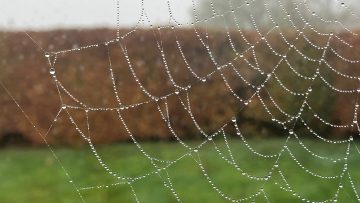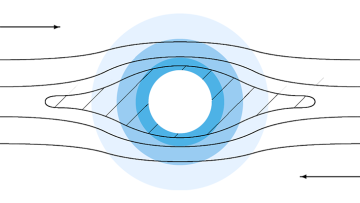 Fluids play a vital role in a wide variety of industries, from packaging manufacturers to pharmaceutical companies. Understanding how to best manage the use of fluids is important for companies wishing to remain efficient and competitive, and many have partnered with mathematicians such as Mark Wilson at the University of Leeds to help solve their problems.
Fluids play a vital role in a wide variety of industries, from packaging manufacturers to pharmaceutical companies. Understanding how to best manage the use of fluids is important for companies wishing to remain efficient and competitive, and many have partnered with mathematicians such as Mark Wilson at the University of Leeds to help solve their problems.
A common application of fluids within industry is coating, used to produce everything from waterproof jackets to glazed doughnuts. One widely-used method of coating is to pass objects through a falling sheet of liquid. This method, known as curtain coating, produces the coated paper used in products such as drinks cartons. A large roll of paper is passed under a continuously falling “curtain” of liquid that deposits a layer not much thicker than a human hair on to the surface. Once the liquid coating has been applied, the material is then dried and cut to the required shape.
Ideally this system would be driven as fast as possible to achieve maximum productivity, but the liquid layer becomes unstable when the paper roll moves beyond a certain speed. The continuous flow of liquid becomes jagged, leaving air bubbles and other inconsistencies in the coating and rendering the packaging material useless. Manufacturers can perform experiments to determine the maximum possible speed for different combinations of liquids and materials, but developing a mathematical model is both cheaper and more flexible.
An important parameter in a curtain coating model is the contact angle, the angle at which the liquid hits the surface being coated. This depends on the speed at which the surface passes through the liquid, and can be difficult to predict mathematically. Current methods require that the contact angle is determined through experimentation, so that the parameter can be used in the model to calculate other factors. Wilson hopes to eventually develop a method that can accurately predict the contact angle and incorporate the result in to the model, removing the need for experimentation entirely and providing a more flexible technique for manufacturers.
Developing these models is a difficult task because key elements of the coating process occur at different length scales. There are models for the chemical interactions between the different materials involved, but these are mathematically incompatible with models for the flow of liquid on the macroscopic human scale. Working out how to accurately marry these two kinds of modelling together is an active area of mathematical research being undertaken by Wilson and others.
Another growing application for fluid modelling in industry is the development of new inkjet technology, an area in which the UK is a world leader. Although most commonly employed for printing images, inkjet printing is also used industrially to produce a range of items such as circuit boards or pharmaceuticals. For example, Wilson is part of a team currently working with the pharmaceutical company GlaxoSmithKline and the Technology Strategy Board to print the active ingredients for drugs on to blank tablets. They hope this will speed up production of new medicines, and potentially allow multiple drugs to be combined on to a single pill.
The liquid pharmaceutical suspensions used for this process contain a higher level of solid particles than the inks used for desktop printing, and the droplets are also much larger. These differences mean that standard inkjet technology is not up to the task of producing drugs, but mathematical modelling can help adapt and develop new techniques.
 The team is using modelling to analyse the behaviour of these new inkjet systems, determining the optimal range of values that important parameters should take, such as the pumping rate of the liquids, or the size and shape of the inkjet nozzle. It is hoped that the work will eventually allow GlaxoSmithKline to significantly increase the number of new products based on printing technology.
The team is using modelling to analyse the behaviour of these new inkjet systems, determining the optimal range of values that important parameters should take, such as the pumping rate of the liquids, or the size and shape of the inkjet nozzle. It is hoped that the work will eventually allow GlaxoSmithKline to significantly increase the number of new products based on printing technology.
Wilson is also part of a larger research project called Innovation in Industrial Inkjet Technology. Led by the Inkjet Research Centre at the University of Cambridge, it links academics across the country with a range of industrial partners to develop new possibilities for inkjet technology. Mathematical modelling is a key tool in understanding the underlying phenomena and also in creating a “design toolbox” for industrialists to enhance their systems.
Modelling fluid behaviour is a challenging field of mathematics, but solving the problems with these coating and inkjet techniques – and many other fluid problems – is vital to industries working with fluids. However, many companies do not have the resources to fund an entire research project, so public funds are essential. The University of Leeds has successfully collaborated with a number of companies in the Yorkshire and North East region to solve key problems, aided by grants from Regional Development Agencies and the Research Councils. Developing these partnerships is beneficial to all involved, as mathematicians such as Wilson are able to put their theories to the test in a real-world setting, and companies gain access to the advanced skills that academic mathematicians can provide.
Technical Supplement
The contact angle
A drop of liquid always rests on a solid surface at a particular angle, close to zero for absorbing materials such as tissue paper and increasing to over 90 degrees for hydrophobic materials. In static situations the size of the angle depends only on the chemical properties of the liquid, solid and surrounding air, but it can approach 180 degrees in dynamic situations where the solid surface is moving.
The contact angle is a boundary condition for problems involving liquids wetting surfaces, placing an additional constraint on the mathematical models developed by Wilson and others. It is not possible to predict the contact angle in dynamic situations such as curtain coating using standard mathematical approaches, so it has to be determined through experimentation. Relying on empirical data dilutes the power of the model, but Wilson hopes to develop a genuinely predictive model that can do away with this extra step.
Micro vs macro
Traditional fluid mechanics is based on the continuum hypothesis, which states that a fluid consists of a continuous substance, rather than discrete molecules. Under this hypothesis the space between fluid particles is zero, meaning that it is impossible to account for chemical effects from individual molecule interactions. This approach works well for many situations involving fluids, but molecular effects are extremely important when it comes to wetting problems, as the contact angle problem demonstrates. The difficulties in modelling wetting using a traditional approach were first highlighted in 1971 by Chun Huh and Skip Scriven, and a satisfactory complete model has still not been developed.
The disparity between the micro and macro worlds is most apparent in the interface between the liquid and the surrounding air. This region is traditionally modelled as a mathematical surface with zero thickness, on which molecular effects are represented by macroscopic properties such as surface tension, and boundary conditions applied on the surface. A potential modification, known as a diffuse interface model, gives the region a finite thickness containing a blend of liquid and air. These models are theoretically correct and offer solutions to the key problems with the traditional approach, but in practice the interface region must be unrealistically thick in order to compute the results in a reasonable amount of time, currently limiting them to providing qualitative rather than quantitative answers.
References
Huh, C. & Scriven, L. E. (1971) Hydrodynamic model of steady movement of a solid/liquid/fluid contact line. Journal of Colloid and Interface Science, 35(1), 85-101. DOI: 10.1016/0021-9797(71)90188- 3
Wilson, M.C.T., Lee, Y.C., Kapur, N., Summers, J.L., Thompson, H.M. & Gaskell, P.H. (2005) Numerical simulation of thin film coating and spreading flows: current capabilities and future trends. Trends in Chemical Engineering, 9, 43-54.
Wilson, M.C.T., Summers, J.L., Shikhmurzaev, Y.D., Clarke, A. & Blake, T.D. (2006) Nonlocal hydrodynamic influence on the dynamic contact angle: Slip models versus experiment. Physical Review E, 73(4), 041606. DOI: 10.1103/ PhysRevE.73.041606
EPSRC Grants
Reference: EP/H018913/1
Title: Innovation in industrial inkjet technology – I4T
Reference: EP/F0650I9/I
Title: Forced and natural wetting on non-uniform surfaces: overcoming obstacles to predictive modelling
The IMA would like to thank Dr. Mark Wilson, University of Leeds for his help in the preparation of this document.



